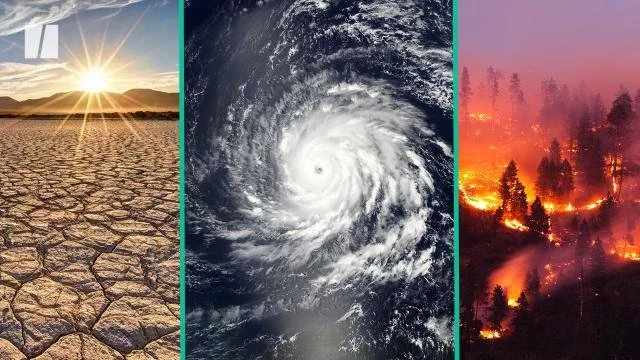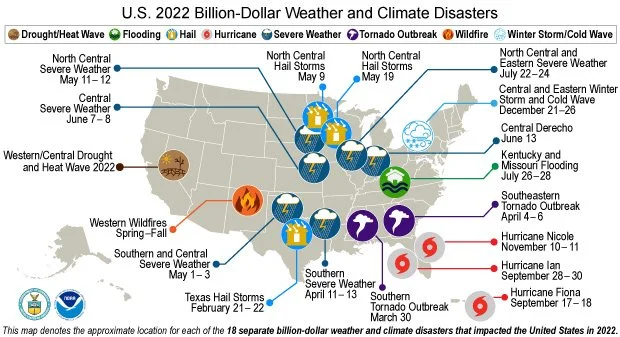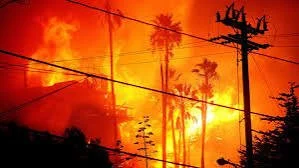LIVING IN A WORLD OF EXTREME WEATHER EVENTS
Image courtesy of Yahoo News
Global climate change fueled by human activities, primarily the burning of fossil fuels, along with deforestation, nonregenerative agriculture, decomposition of waste in landfills and some forms of industrial production (Cement industry) produce the Greenhouse gas carbon dioxide (CO₂). CO₂ accounts for approximately 76% of total Greenhouse gases. Greenhouse gases prevent heat from solar radiation, and to some lesser extent geothermal, from escaping the Earth resulting in an increase in global warming which severely impacts the environment. While Methane is the most “potent” contributor to greenhouse gases, CO₂ is the “largest” contributor. The consequences of global warming are extreme weather events which includes; but are not limited to: warmer oceans fueling stronger—deadlier—and more frequent hurricanes, acidification of ocean waters, irregular plants / trees life cycle seasonal changes, animal species extinctions, intensity of tornadoes, reduced seasonal frost, torrential rainfalls, reduced air quality from particulate matter formed from wildfires, extreme heat, desertification, melting glaciers, sea ice and thawing permafrost, sea coral bleaching . . .
Since the start of the 18th century Industrial Revolution the Earth has warmed 1.1° C (1.9° F). According to climate scientists, a 3 degrees increase in global warming can be catastrophic to the inhabitants of the Earth.
Image courtesy of Climate.GOV
The zero emissions goal of the Tiny Off Grid House is not intended to have grandiose ambitions of being a panacea for ending climate change. However, the sustainable design and lifestyle it facilitates for the occupants significantly reduces, if not, eliminates any potential contributions made towards climate change. Researching the potential scalability of this sustainable design and lifestyle, in to practice in sustainable communities, may enable an incremental reversal of global climate change.
A Tiny Off Grid House has the potential of mitigating some of the impacts of extreme weather events that could be imposed on its occupants through its resilient design, off-grid capabilities and mobility.
OFF-GRID When extreme weather threatens the electrical grid the Tiny Off Grid House will not be impacted since electrical energy is produced inherently from renewable energy sources and stored in lithium batteries; independently from the commercial electrical grid.
The solar array is capable of generating 20.0 KWh daily with a Battleborn Lithium battery storage bank of 28.8Kwh. Supplemental off-grid energy can be generated from micro wind or micro hydro renewable sources.
The Tiny off Grid House onboard water treatment system has the ability to filter domestic water and store, a minimum of, 55 gallons of filtered water in an indoor food-grade container. The indoor container is protected from outdoor temperature extremes and damaging UV rays.
RESILIENT DESIGN The Tiny Off Grid House air tight building envelope uses closed cell foam insulation to maintain a controlled indoor temperature and humidity level; regardless of the cold or heat conditions outside. A Mini Split provides indoor heating, dehumidification and air conditioning. Unfortunately, many people, even in industrialized countries, can not afford the high cost of fossil fuel generated electrical energy needed for operating air conditioning and this has been fatal for vulnerable populations (The elderly & low income) during extreme heat waves. It is believed that 1 in 4 American households face energy insecurity. This is a national concern since energy utilities, in 31 states, can disconnect electricity for nonpayment during a heat wave. In the state of Texas, there were 13 heat-related deaths during the heat wave in June of 2023. As the frequency of climate change temperature events increases the Tiny Off Grid House will be able to create a comfortable indoor temperature, generated by a mini split, and maintained by an envelope of high R-value wall insulation along with a high performance door and double-pane windows. Of course the power needed to power the mini split will come from renewable sources.
The standing seam metal roof is made of marine grade Aluminum (Al) panels, along with the cladding (Siding) vertical boards and batten panels are: corrosion resistant, very lite weight, non porous, UV color stable, requires little if no maintenance, provides protection against insects (Termites), fire embers, is resistant to salt water corrosion and dissipates heat faster than wood. The 24 gauge Aluminum is 100% recyclable infinitely without loosing its quality each time, a Class A fire resistant and non-combustable—which is an asset in fire prone environments.
The Huberwood ZIP System® Insulated R-Sheathing and Flashing Tape is a building enclosure that provides a rigid thermal & fire resistance with an integrated moisture/air barrier. It is designed to create an air tight envelope that maintains the inside conditioned temperature while inversely insulating the Tiny House from external heat sources.
The Tiny Off-Grid House maintains indoor air quality with a “pair” of Lunos e²60 Heat Recovery Ventilator (HRV) systems operate to continuously provide balanced mechanical ventilation at up to 22 CFM (Spaces under 1000 SF). Each alternating between positive or negative air flows with a 90.6% heat recovery efficiency.
According to 475 High Performance Building Supply, the manufacturer of the Lunos e²60, their MERV 13 (Filters) reduces particulate matter 2.5 by up to 90% the dominant size of particulate from wildfire smoke.”
Image courtesy of Ventura County Star
MOBILITY The Thomas Fire, which ignited on December 4, 2017, burned Santa Barbara & Ventura counties in California. According to the Ventura California Fire Department (VCFD) fire investigators, the fire was caused by Southern California Edison (SCE) faulty power lines making contact causing an arc which ignited the combustible dry bushes on the ground. The fire destroyed 2811,893 acres, 1,063 structures.
The fatalities included one civilian and a Fire Fighter.
The intensity of the fire even caused the ground to congeal creating an impermeable top layer. On January 9, 2018, heavy rains caused massive flooding and mudflows ravaging the seaside town of Montecito; resulting in 21 fatalities, with the bodies of 2 people never found—as of the time of this writing.
Weather related fires are contributing to poor air quality. Particulate pollution (PM2.5)—1/20 the diameter of a human hair— either gets stuck in the small capillaries of the lungs or are small enough to be transferred directly in to the blood stream; reaching the brains & every organ. Researchers connect particulate pollution to 1 in 5 fatalities globally.
Ryan, an owner of a 28 ft long Tiny House on wheels was able to safely relocate his house away from the approaching fires that devastated the town of Ojai, in Ventura County. With sufficient warning of some extreme weather events such as wildfires or floods . . . the mobility of the Tiny Off Grid House on wheels can offer the occupants the opportunity of relocating their house to safer areas.
The fires initiated by corporate greed & neglect of electrical equipment was made worse by extreme weather events. Climate Change creates conditions that are conducive to forest fires. Droughts dry up water resources providing the fire with the fuel it needs, like dry bushes and grasses. The fires moved rapidly by strong winds driven by intensification in atmospheric pressures from climate change.
According to a United Nations report, in 2022 an estimated 3.4 million Americans (1.4% of U.S. adult population) were displaced from their homes by extreme weather events becoming climate change refugees. Migration has always existed as a voluntary, planned, human response to seasonal changes in the environment and / or following herd migrations. Compare to climate change refugees whom are imposed with involuntary evacuation of their homes & lands to escape the “preventable” impacts of extreme weather events; including wars. Surely, water insecurity will be a primary catalyst of future wars between nations.
Image courtesy of Alaska Dept. of Commerce
In 2019 the Yup’ik became climate change refugees when they had to permanently evacuate their homes in the Eskimo village of Newtok, Alaska, along with their traditional hunting grounds of seal, moose and native plants due to: storm surges, melting permafrost and land erosion at the Ninglick River and Bering Sea coastline. It has been reported, the rising waters of the Ninglick River has caused approximately 60 feet of soil erosion per year. Researchers believe the island could be submerged within a decade.
It remains to be seen what Archaeologist and Social Researchers will find concerning the impact, if any, this climate change forced migration will have on the Yup’ik maintaining their culture and subsistence way of life? The people whom contribute the least to climate change are usually the ones that suffer its impacts the most.
Please share your thoughts or experiences in the Comments section below.



